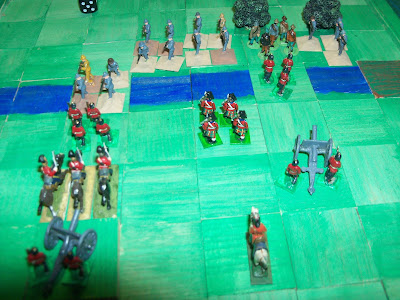This week I had time for two wargames. The goal was to try out new rules. One was to try my Chessboard Campaign; the other Bob Cordery's "Portable Wargames", with a change to one of the rules.
The "Chessboard Campaign" didn't work out as planned. Usually using the Horse & Musket 2.0 rules, most of the action takes place in the center of the board. I used my house rules to fight an ancients battle between Turks and Arabs. The Arabs succeeded in pushing the Turks to their back line before the Turks lost 50% of their army. Using my proposed campaign rules, the Turks would have no room to maneuver in the next game. Any army in such a situation would probably retreat to fight another day. So it's back to the drawing board for the Chessboard Campaign, although I do have another idea for my chessboard.
I decided to try to take another look at Bob Cordery's Portable Wargames. In his rules, one rolls to see if their unit hits the opponents unit. If they score a hit, they then roll for the results. I just roll two dice; one for hits, the other for results if they score a hit. I also changed the rule where if certain pips comes up, the unit can choose to either loss one strength point, or retreat one square. For my game, the unit retreats, unless it can't retreat. At that point they lose the SP. A nice simple fix to having built in automatic retreats. I then made a mistake that affected the trail run. I chose the armies and scenarios based on Neil Thomas' One Hour Wargame. The armies were fine, however, the scenario chosen was #3, which was a river crossing where the goal is to seize two bridges. This led to a game where the armies were bottlenecked into two areas, and the game bogged down. That, along with me referring to the rulebook constantly, slowed the game to a crawl. I should have just used an open terrain field to learn the basics of the rules.
 |
| The Turks are on the left, the Arabs on the right. |
 |
| The figures on the white horses on the baselines were the "Headquarters" that the other side must capture. |
 |
| The Turks have dropped below 50%, ending the battle. |
 |
| In my proposed campaign rules, the Turks would deploy on the squares behind the blue chalk line. As can be seen , there is no room for the Turks to really do any maneuvering. Back to the drawing board! |
 |
| Portable Wargame. British army on the top; Boers on the bottom. This game gave me a chance to use my newly acquired Peter Laing Victorian Parade figures. |
 |
| Both armies advances. |
 |
| Artillery fire pushes one Boer unit back. At first I rolled for initiative, then realized that I forgot that artillery fire is supposed to take place before movement. Also, this was a solo game. However, I didn't use the solo rules that are mentioned in Portable Wargames. I really wanted to get a feel for the rules. Both sides got to move all units each turn. |
 |
| As can be seen from the above photos, the games was a back and forth game. For me the game bogged down. I think the game would have been more enjoyable with an open field to allow more maneuver, at least until I get the rules down pat. Of course, I only read the rules once (I try to read them three times before playing) proving that even simple rules aren't so simple! |

























































